

Rent Controls in Wales - follow the evidence
Introduction: The threat of rent controls in Wales
The Welsh Government has committed to exploring rent controls as part of its Co-operation Agreement with Plaid Cymru. The introduction of rent controls would have a dramatic impact on the sector in Wales.
In the Co-operation Agreement signed by the Welsh Government and Plaid Cymru a commitment was included to publish a White Paper which would explore how “fair rents” might be able to make the private rented sector affordable for local people on local incomes. No further details have been published at this stage, but this appears to set the ground for the introduction of some form of rent controls in Wales.
Types of rent controls
Rent control as a policy instrument has morphed over time and in different locations to suit local circumstances. The conventional linear time-based perspective on rent controls identifies the evolution of policy as follows:
-
First generation rent controls - Rents are fixed and remained unchanged for properties over long periods of time. Typically, this was done by restricting rent to a level based on a specified date. In England & Wales the clearest example is given by the Increase of Rent and Mortgage Interest (War Restrictions) Act 1915 which restricted rents to their level as at August 1914 in order to prevent war profiteering. This approach to rent control has largely disappeared but can occasionally be found in some jurisdictions.
-
Second generation rent controls - These are essentially some form of ‘inflation plus’ method of controlling rental price increases (economists will recognise the “RPI+X” approach is aligned to the “RPI-X” formula for price capping regulation the UK government trumpeted during the 1980s and 1990s in their privatisation drive.) Some level of rent increase is permitted - usually to provide encouragement to improve property - but they seek to control rents tightly both between and during tenancies. This may be either by reference to an external marker or by allowing recovery of improvement costs.
In the UK, second generation rent controls were typified by the mechanism which existed under the Rent Act 1977. However, they can still be found in relatively modern legislation. For example, Part IV of the Private Tenancies (Northern Ireland) Order 2006 imposes second generation rent control on older properties that have not been modernised to a required standard. However, these provisions have yet to be brought fully into force.
-
Third generation rent controls - These are not dissimilar to those found in second generation controls but tend to operate as a more liberal regime. These allow initial rents (i.e. new tenancies) to be set freely by landlords or with a very light restriction but limit rent increases within tenancies. It is usual to find in-tenancy increases are generally set at a level which is higher than those found under second generation controls (these are often called ‘tenancy rent controls’ – Arnott, R. (2003). Tenancy Rent Control. Swedish Economic Policy Review, 10, 89-121). Countries that have retained rent control in some form tend towards third generation systems. These systems have more recently been put forward as a mechanism to deal with rents that are perceived as rapidly rising in a specific area. These are often seen as attempts at ‘rent-stabilisation’ rather than rent control.
The reality of rent controls
Prior to the creation of the NRLA, the RLA took a close look at rent controls. Drawing on the experience of those cities where rent controls had been introduced.
The report explains the difficulties individual cities such as Berlin have had in creating a legal, viable rent control framework. In Berlin there is evidence of each of the above drawbacks. Just last week, Germany’s highest court ruled Berlin’s rent caps were illegal. This is the latest blow to the city’s rent control regime which are now evidentially damaging tenant choice and landlords.
The Berlin evidence also shows that would-be tenants become “locked out” of cities whilst residents of rent-controlled accommodation remain in situ.
It is also proving costly for the city to maintain rent controls – investment in the city’s housing stock is being choked, and the city’s taxpayers must meet the cost of ongoing court challenges and reviews.
There can also be unintended consequences of rent controls when implemented, such as:
-
Changing behaviour on both the demand and supply side of the PRS market in response to policy.
-
Regulatory failings – the administration of schemes expand and becomes more expensive and complex, undermining the intended simplicity of the scheme.
-
Unfair advantages landlords who remain in the PRS may gain as result of the complexities of the system and a court system under strain.
-
The wider economic impacts of resulting labour market rigidities.
-
The inability of cities to properly address the real causes of housing shortages
-
The difficulties in properly evaluating and assessing rent control policy. The lack of clear, impact-based evidence leaves the door ajar for lobby groups to have undue influence on policy.
The complexities in quantifying the impact of rent controls on supply, price and future investment in Wales are however secondary to a rather more fundamental question – are rent controls in Wales needed? The evidence of private sector rent levels - on which the NRLA regularly reports - suggests the policy is simply not necessary.
Evidence of rent increases
The Index of Private Housing Rental Prices (IPHRP) is an index tracking the prices paid for renting property from private landlords in the UK. Like other price indices such as the CPI, this index is compiled by the ONS.
It is the best available measure of housing costs in the Private Rented Sector amongst both new and existing tenants. Other measures of rental price change typically produced by the real estate industry, tend to reflect recent letting transactions. These do not account for longer-held tenancies.
In regular policy surveys, the NRLA consistently report that when asked, most landlords state they have not raised rents in the previous twelve months.
Chart 1 below shows that the gap between rental growth is widening, with Wales rent growing slower than the rest of the UK.
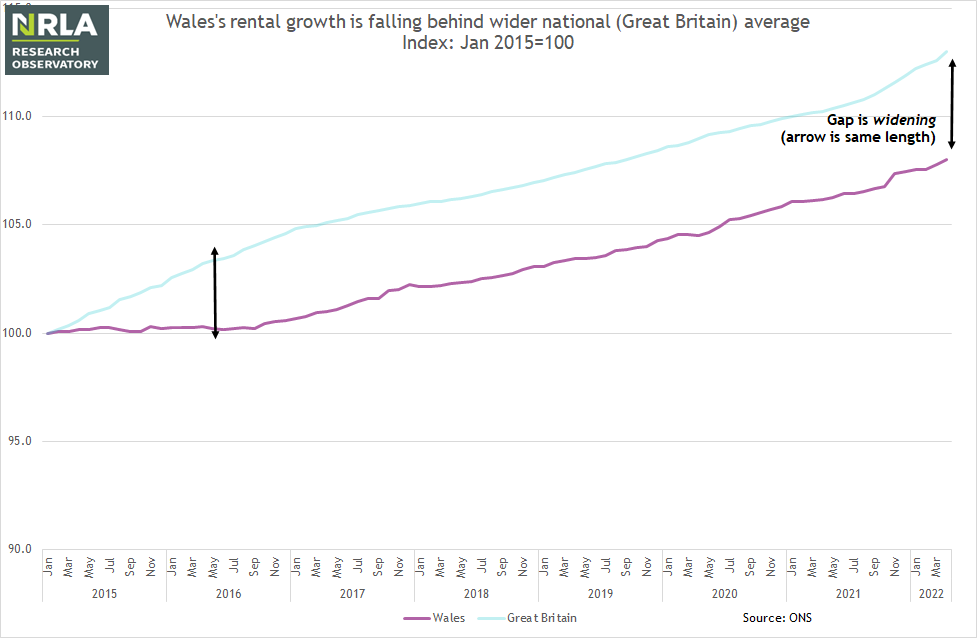
Since January 2015, private rental prices in Wales have risen by 8% compared with a 12.6% increase across the rest of the UK.
Chart 2 shows the rapid rise in CPI and CPIH in comparison to rent.
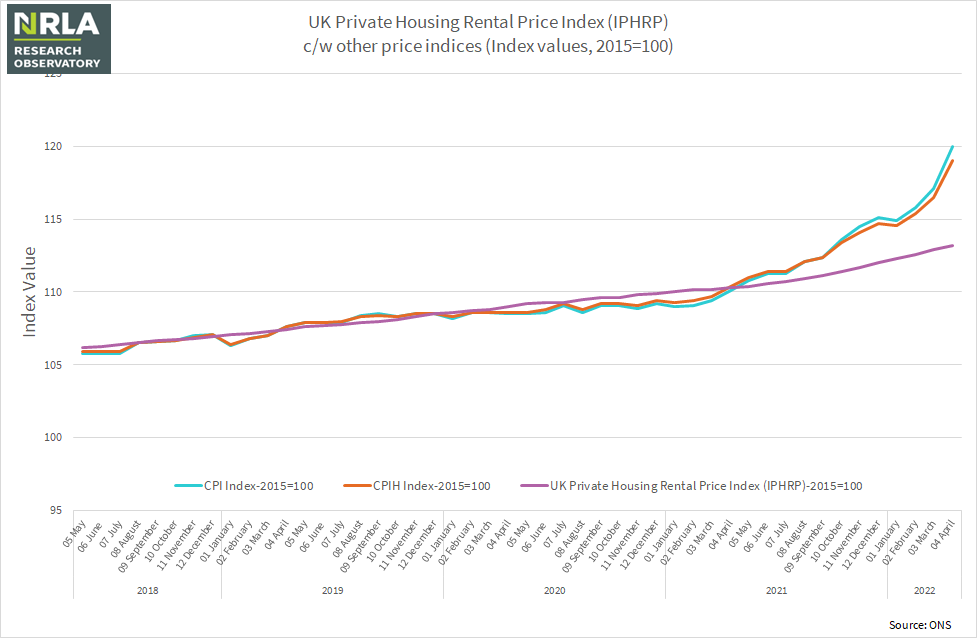
In the graph above, we can see that both the CPI (consumer price change) and the CPIH (which includes owner occupiers’ housing costs rate) begin to rise more significantly above the UK Private Housing Rental Price Index (IPHRP). This trend started in March 2020 and continues to rise.
Chart 3: The annual rental price growth in Wales has now dropped back below the UK average growth.
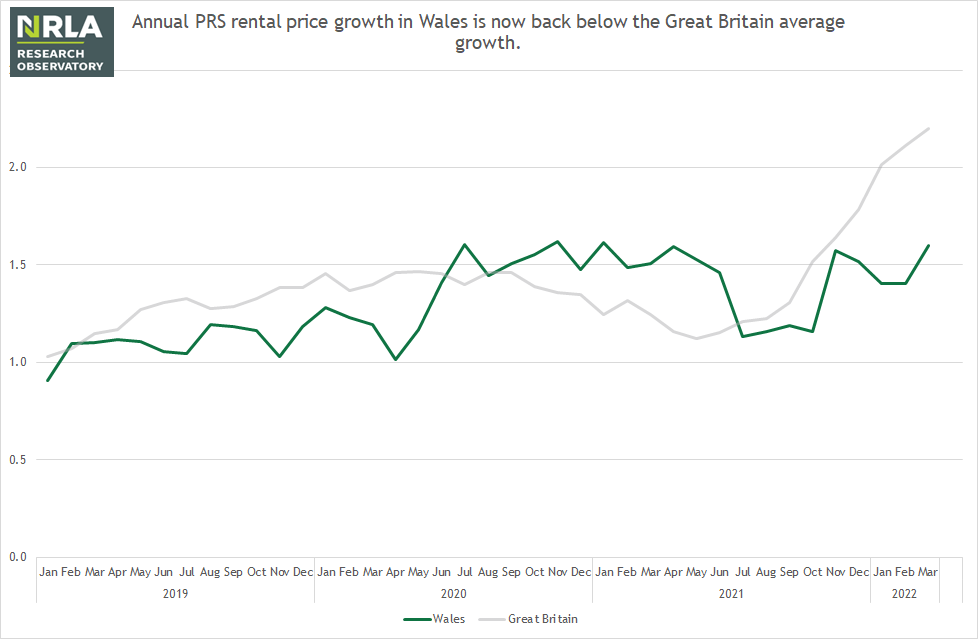
Private rental prices in the 12 months from March 2021 to March 2022 in Wales dipped to 1.1% in July 2021, before increasing up to 1.6% in March 2022, matching its increase in November 2020 and July 2020.
Despite rental price growth during parts of 2020 and 2021, Wales’s rental growth as measured by the ONS is typically lower than that of Great Britain as a whole. Wales’s private rental prices are now significantly smaller than the rest of the UK.
Landlord confidence
With landlords with properties in Wales facing a combination of low rent increases AND the threat of rent controls there is no wonder confidence is low.
Our Landlord Confidence Index consistently shows landlords with portfolios focused in Wales are among the least positive landlords in Wales and England.
Chart 4 below shows the Landlord Confidence Index scores for Wales.
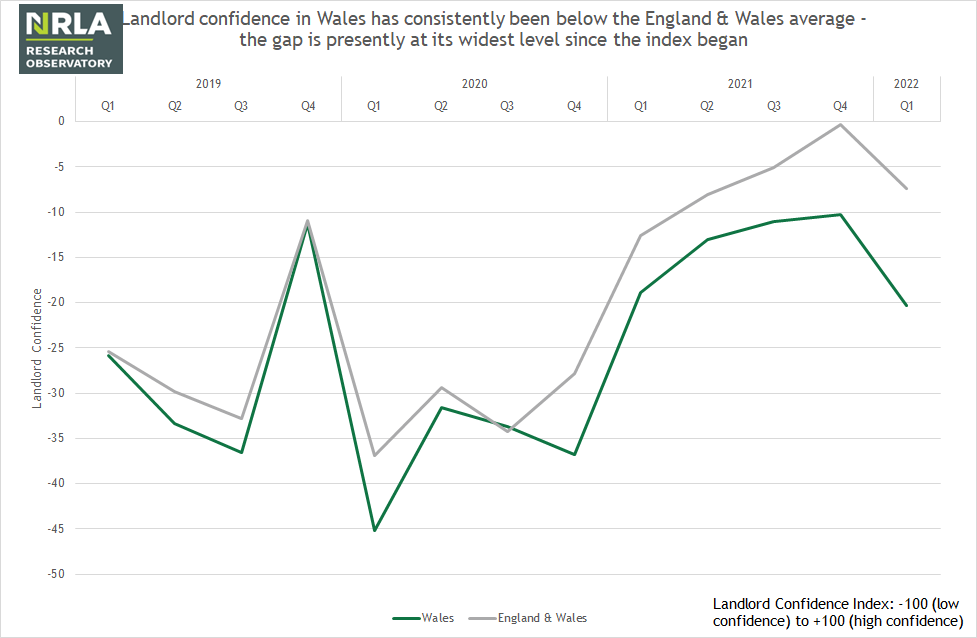
In the last nine quarters, landlords with properties in Wales have featured among the lowest confidence-scoring landlords on seven occasions.
Conclusions
Rent controls may sound an easy solution in areas of high demand. However, rent controls would not solve the issue of housing shortages. They would instead be catastrophic to the Private Rental Sector, creating market distortions, and labour market rigidities (as mentioned previously in this blog). Quantitative evidence consistently shows over time that tenants, would-be tenants, and landlords, all suffer where rent controls are imposed.
A key question must also be to ask why the need to introduce such controls now? Rents in Wales are not rising at an alarming rate.
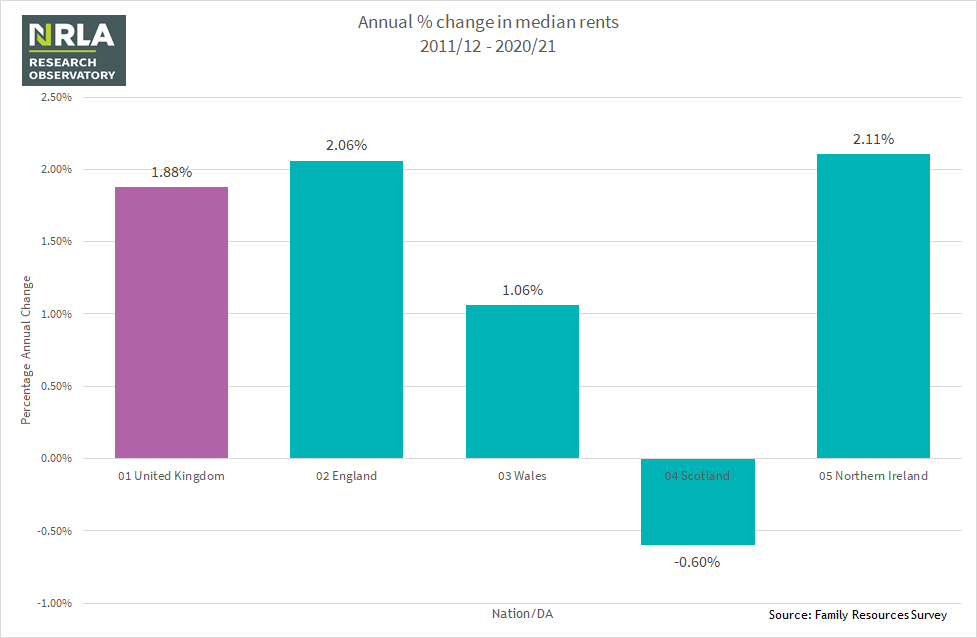
The chart above shows that long term rental increases are modest - and this time, the data here is consistent with the more detailed IPHRP index.
-
In England median rents over the last ten years have increased by just over 2%pa.
-
Even this modest growth is way ahead of that experienced in Wales and Scotland.
-
In Wales long term rental growth has been modest - but the most recent year has seen a sudden jump in the data presented by the FRS (This differs from the data the NRLA regularly analyses elsewhere in this blog. This possibly reinforces the impact of the pandemic on data collection e.g. small sample sizes among other factors).
Imposing rent controls could mean locking in mandatory annual price rises for tenants. At present many landlords (in fact most landlords in NRLA member-surveys) are currently not raising annual rents.
As the Welsh economy recovers from Covid-19, it should be a priority to address the lack of supply in the sector by improving standards in the private rental sector and boosting the supply of private rented homes. The UK needs almost 230,000 new private rented homes a year to meet government housing targets across the UK. It should also be a priority to develop a Welsh housing survey, so that evidence can be effectively gathered from landlords in the PRS to develop better housing policy.
The development of an unfair, flawed, and evidence lacking rent controls policy would be detrimental to the sector and the Welsh economy. All the evidence collected from post-war western economies indicates a policy whose intention is to soften the cost-of-living crisis, will make it harder for tenant and landlord alike.

